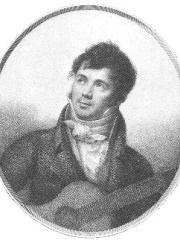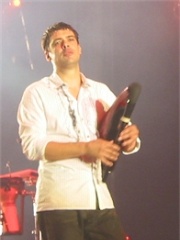







The Most Famous
MUSICIANS from Spain
Top 10
The following people are considered by Pantheon to be the top 10 most legendary Spanish Musicians of all time. This list of famous Spanish Musicians is sorted by HPI (Historical Popularity Index), a metric that aggregates information on a biography's online popularity. Visit the rankings page to view the entire list of Spanish Musicians.

1. Isaac Albéniz (1860 - 1909)
With an HPI of 76.13, Isaac Albéniz is the most famous Spanish Musician. His biography has been translated into 56 different languages on wikipedia.
Isaac Manuel Francisco Albéniz y Pascual (Spanish pronunciation: [iˈsak alˈβeniθ]; 29 May 1860 – 18 May 1909) was a Spanish virtuoso pianist, composer, and conductor. He is one of the foremost composers of the post-romantic era who also had a significant influence on his contemporaries and younger composers. He is best known for his piano works that incorporate Spanish folk music idioms and elements. His compositions, particularly those in his suite Iberia (1905–1908), are considered masterpieces and have influenced both classical music and Spanish nationalism in music. Isaac Albéniz was close to the Generation of '98. Transcriptions of many of his pieces, such as Asturias (Leyenda), Granada, Sevilla, Cadiz, Córdoba, Cataluña, Mallorca, and Tango in D, are important pieces for classical guitar, though he never composed for the guitar. Some of Albéniz's personal papers are held in the Library of Catalonia.

2. Pablo de Sarasate (1844 - 1908)
With an HPI of 73.53, Pablo de Sarasate is the 2nd most famous Spanish Musician. His biography has been translated into 46 different languages.
Pablo Martín Melitón de Sarasate y Navascués (Spanish pronunciation: [ˈpaβlo saɾaˈsate]; 10 March 1844 – 20 September 1908), commonly known as Pablo de Sarasate, was a Spanish violinist, composer and conductor of the Romantic period. His best known works include Zigeunerweisen (Gypsy Airs), the Spanish Dances, and the Carmen Fantasy.

3. Pablo Casals (1876 - 1973)
With an HPI of 73.47, Pablo Casals is the 3rd most famous Spanish Musician. His biography has been translated into 50 different languages.
Pau Casals i Defilló (Catalan: [ˈpaw kəˈzalz i ðəfiˈʎo]; 29 December 1876 – 22 October 1973), also known in English as Pablo Casals, was a Catalan and Puerto Rican cellist, composer, and conductor, born in Spain. He made many recordings throughout his career of solo, chamber, and orchestral music, including some as conductor, but he is perhaps best remembered for the recordings he made of the Cello Suites by Bach. He was awarded the Presidential Medal of Freedom in 1963 by President John F. Kennedy (though the ceremony was presided over by Lyndon B. Johnson).

4. Paco de Lucía (1947 - 2014)
With an HPI of 73.06, Paco de Lucía is the 4th most famous Spanish Musician. His biography has been translated into 59 different languages.
Francisco Gustavo Sánchez Gómez (Spanish: [fɾanˈθisko ɡusˈt̪a.β̞o ˈsantʃeθ ˈɣomeθ]; 21 December 1947 – 25 February 2014), known as Paco de Lucía (Spanish: [ˈpako ðe luˈθi.a]), was a Spanish virtuoso flamenco guitarist, composer, and record producer. A leading proponent of the new flamenco style, he was one of the first flamenco guitarists to branch into classical and jazz. Richard Chapman and Eric Clapton, authors of Guitar: Music, History, Players, describe de Lucía as a "titanic figure in the world of flamenco guitar", and Dennis Koster, author of Guitar Atlas, Flamenco, has referred to de Lucía as "one of history's greatest guitarists". De Lucía was noted for his fast and fluent picados (fingerstyle runs). A master of contrast, he often juxtaposed picados and rasgueados (flamenco strumming) with more sensitive playing and was known for adding abstract chords and scale tones to his compositions with jazz influences. These innovations saw him play a key role in the development of traditional flamenco and the evolution of new flamenco and Latin jazz fusion from the 1970s. He received acclaim for his recordings with flamenco singer Camarón de la Isla in the 1970s, recording ten albums which are considered some of the most important and influential in flamenco history. Some of de Lucía's best known recordings include "Río Ancho" (later fused with Al Di Meola's "Mediterranean Sundance"), "Entre dos aguas", "La Barrosa", "Ímpetu", "Cepa Andaluza" and "Gloria al Niño Ricardo". His collaborations with guitarists John McLaughlin, Al Di Meola and Larry Coryell in the late 1970s saw him gain wider popularity outside his native Spain. De Lucía formed the Paco de Lucía Sextet in 1981 with his brothers, singer Pepe de Lucía and guitarist Ramón de Algeciras, and collaborated with jazz pianist Chick Corea on their 1990 album, Zyryab. In 1992, he performed live at Expo '92 in Seville and a year later on the Plaza Mayor in Madrid. He also collaborated with guitarist Juan d'Anyelica on his album Cositas Buenas. After 2004 he greatly reduced his public performances, retiring from full touring, and typically only gave several concerts a year, usually in Spain and Germany and at European festivals during the summer months.

5. Fernando Sor (1778 - 1839)
With an HPI of 69.88, Fernando Sor is the 5th most famous Spanish Musician. His biography has been translated into 35 different languages.
Fernando Sor (baptised 14 February 1778 – 10 July 1839) was a Spanish classical guitarist and composer of the late Classical era and early Romantic era. Best known for writing solo classical guitar music, he also composed an opera (at the age of 19), three symphonies, guitar duos, piano music, songs, a Mass, and at least two successful ballets: Cinderella, which received over one hundred performances, and Hercule et Omphale. Partly because Sor was himself such a classical guitar virtuoso—contemporaries considered him to be the best in the world—he made a point of writing didactic music for players of that instrument of all levels. His Twelve Studies Op. 6, the Twelve Studies Op. 29, the (24) Progressive Lessons Op. 31, and the (24) Very Easy Exercises Op. 35 have been widely played for two hundred years and are regularly reprinted. On the other hand, Sor's concert pieces, like the popular Introduction and Variations on Mozart's "Das klinget so herrlich" Op. 9, belong to the advanced guitar performance repertoire. Unlike modern classical guitar players, Sor used the smaller, slimmer "Romantic" guitars predating today's familiar guitar standards set by Torres. He used the ring finger of his plucking hand "rarely" and "only for harmony (never for melody)." He eschewed the use of nails on that hand.

6. Andrés Segovia (1893 - 1987)
With an HPI of 69.12, Andrés Segovia is the 6th most famous Spanish Musician. His biography has been translated into 46 different languages.
Andrés Segovia Torres, 1st Marquis of Salobreña (21 February 1893 – 2 June 1987), was a Spanish virtuoso classical guitarist. Many professional classical guitarists were either students of Segovia or students of Segovia's students. Segovia's contribution to the modern-romantic repertoire included not only commissions but also his own transcriptions of classical or baroque works. He is remembered for his expressive performances: his wide palette of tone, and his distinctive musical personality, phrasing and style.

7. Narciso Yepes (1927 - 1997)
With an HPI of 65.77, Narciso Yepes is the 7th most famous Spanish Musician. His biography has been translated into 25 different languages.
Narciso Yepes (14 November 1927 – 3 May 1997) was a Spanish guitarist. He is considered one of the finest virtuoso classical guitarists of the twentieth century.

8. Dionisio Aguado y García (1784 - 1849)
With an HPI of 64.81, Dionisio Aguado y García is the 8th most famous Spanish Musician. His biography has been translated into 19 different languages.
Dionisio Aguado y García (8 April 1784 – 29 December 1849) was a Spanish classical guitarist and composer of the late Classical and early Romantic periods.

9. Alicia de Larrocha (1923 - 2009)
With an HPI of 63.59, Alicia de Larrocha is the 9th most famous Spanish Musician. Her biography has been translated into 28 different languages.
Alicia de Larrocha y de la Calle (23 May 1923 – 25 September 2009) was a Spanish pianist and composer. She was considered one of the great piano legends of the 20th century. Reuters called her "the greatest Spanish pianist in history", Time "one of the world's most outstanding pianists", and The Guardian "the leading Spanish pianist of her time". She won four Grammy Awards, out of fourteen nominations, and a Prince of Asturias Award for the Arts. She is credited with bringing greater popularity to the compositions of Isaac Albéniz and Enrique Granados. In 1995, she became the first Spanish artist to win the UNESCO Prize.

10. Joan Manuel Serrat (b. 1943)
With an HPI of 62.96, Joan Manuel Serrat is the 10th most famous Spanish Musician. His biography has been translated into 35 different languages.
Joan Manuel Serrat Teresa (Catalan pronunciation: [ʒuˈam mənuˈɛl səˈrat]; born 27 December 1943) is a Catalan musician, singer, and composer from Spain. He is considered one of the most important figures of modern, popular music in both Spanish and Catalan languages. Serrat's lyrical style has been influenced by other poets such as Mario Benedetti, Antonio Machado, Miguel Hernández, Rafael Alberti, Federico García Lorca, Pablo Neruda, and León Felipe. He has also recorded songs by Violeta Parra and Víctor Jara. Serrat was one of the pioneers of what is known in Catalan as "Nova Cançó" (Nueva Canción). Joan Manuel Serrat is also known by the names "El noi del Poble-sec" and "El Nano".
People
Pantheon has 35 people classified as Spanish musicians born between 1778 and 1994. Of these 35, 17 (48.57%) of them are still alive today. The most famous living Spanish musicians include Joan Manuel Serrat, Paco Ibáñez, and Pepe Romero. The most famous deceased Spanish musicians include Isaac Albéniz, Pablo de Sarasate, and Pablo Casals. As of April 2024, 4 new Spanish musicians have been added to Pantheon including Fermin Muguruza, Kepa Junkera, and Álvaro Benito.
Living Spanish Musicians
Go to all RankingsJoan Manuel Serrat
1943 - Present
HPI: 62.96
Paco Ibáñez
1934 - Present
HPI: 59.71
Pepe Romero
1944 - Present
HPI: 56.38
Paco Peña
1942 - Present
HPI: 56.37
Tomatito
1958 - Present
HPI: 54.21
Fermin Muguruza
1963 - Present
HPI: 51.36
Mikel Herzog
1960 - Present
HPI: 51.14
Hevia
1967 - Present
HPI: 50.79
DJ Sammy
1969 - Present
HPI: 48.63
Pablo Alborán
1989 - Present
HPI: 45.82
Kepa Junkera
1965 - Present
HPI: 45.56
Carlos Núñez Muñoz
1971 - Present
HPI: 45.37
Deceased Spanish Musicians
Go to all RankingsIsaac Albéniz
1860 - 1909
HPI: 76.13
Pablo de Sarasate
1844 - 1908
HPI: 73.53
Pablo Casals
1876 - 1973
HPI: 73.47
Paco de Lucía
1947 - 2014
HPI: 73.06
Fernando Sor
1778 - 1839
HPI: 69.88
Andrés Segovia
1893 - 1987
HPI: 69.12
Narciso Yepes
1927 - 1997
HPI: 65.77
Dionisio Aguado y García
1784 - 1849
HPI: 64.81
Alicia de Larrocha
1923 - 2009
HPI: 63.59
Ricardo Viñes
1875 - 1943
HPI: 62.07
Nicanor Zabaleta
1907 - 1993
HPI: 59.40
Manny Charlton
1941 - 2022
HPI: 58.56
Newly Added Spanish Musicians (2025)
Go to all RankingsFermin Muguruza
1963 - Present
HPI: 51.36
Kepa Junkera
1965 - Present
HPI: 45.56
Álvaro Benito
1976 - Present
HPI: 43.90
Ismael Serrano
1974 - Present
HPI: 40.12
Overlapping Lives
Which Musicians were alive at the same time? This visualization shows the lifespans of the 18 most globally memorable Musicians since 1700.

















